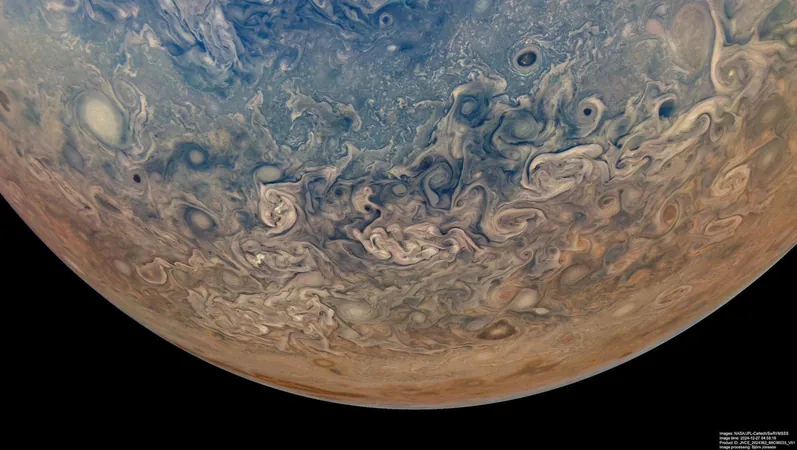
Stunning New Images of Jupiter and Its Volcanic Moon Io Captured by NASA’s Juno Spacecraft!
2025-01-10
Author: Ming
Stunning New Images of Jupiter and Its Volcanic Moon Io Captured by NASA’s Juno Spacecraft!
NASA's Juno spacecraft has once again astounded the world with breathtaking images of Jupiter, our solar system's largest planet, revealing its mesmerizing atmosphere in stunning detail. During its 68th close flyby on December 28, 2024, Juno’s two-megapixel camera captured vivid images as it soared just a few thousand miles above Jupiter's turbulent cloud tops.
This latest batch of data marks a significant moment in Juno's mission as it enters its final year of exploration. As always, citizen scientists have been instrumental in processing these extraordinary images, piecing together the visual details that showcase Jupiter’s swirling storms and intricate weather patterns. The stunning contrasts between the planet’s vibrant colors and the dark spots of its famous Great Red Spot have captivated astronomers and space enthusiasts alike.
Juno didn’t stop there; it also closely approached Io, one of Jupiter's most intriguing moons and the most volcanically active body in our solar system. Io’s surface, which is constantly reshaped by volcanic eruptions and lava flows, provided a dramatic backdrop against Jupiter's colorful cloud formations. This milestone flyby is part of Juno's ongoing efforts to unravel the mysteries of this fiery moon.
Recent findings from Juno have shed light on Io's extreme volcanic activity, which is primarily driven by tidal forces from Jupiter’s immense gravitational pull. These forces create internal friction within Io, generating heat that leads to the formation of lava lakes and active volcanoes that can reach thousands of degrees Fahrenheit. The Microwave Radiometer onboard Juno has been crucial in measuring this heat, highlighting the dynamic processes at work beneath Io's surface.
Additionally, Juno has contributed to our understanding of Io’s interactions with Jupiter’s powerful magnetosphere. By mapping Io's magnetic field and the plasma that surrounds it, scientists have uncovered how charged particles from Io play a role in Jupiter’s expansive magnetic environment.
Launched in 2011 and arriving at Jupiter in 2016, Juno’s mission has exceeded initial expectations. Designed for a short-term study, it has withstood Jupiter's harsh radiation and challenging atmospheric conditions. However, the mission is drawing to a close, with plans for Juno to intentionally plunge into Jupiter’s atmosphere in September 2025. This sacrificial maneuver is aimed at protecting other potentially habitable moons, particularly Europa, which is teeming with intrigue due to its subsurface ocean.
Looking ahead, NASA's Europa Clipper mission is gearing up for its own exploration of Europa, embarking on a six-year journey to study the moon's icy surface and investigate its potential for hosting extraterrestrial life. Set to arrive by 2030, Europa Clipper will conduct nearly 50 close flybys and perform detailed analyses of Europa’s environment.
In a parallel endeavor, the European Space Agency's JUpiter ICy moons Explorer (JUICE) mission is on course for a 2031 arrival at Jupiter to study its three largest icy moons—Ganymede, Europa, and Callisto—all considered prime contenders in the ongoing search for life beyond Earth. With these exciting missions on the horizon, the quest to understand the giant gas planet and its enigmatic moons continues.
Stay tuned for more thrilling discoveries as humanity reaches for the stars!


 Brasil (PT)
Brasil (PT)
 Canada (EN)
Canada (EN)
 Chile (ES)
Chile (ES)
 Česko (CS)
Česko (CS)
 대한민국 (KO)
대한민국 (KO)
 España (ES)
España (ES)
 France (FR)
France (FR)
 Hong Kong (EN)
Hong Kong (EN)
 Italia (IT)
Italia (IT)
 日本 (JA)
日本 (JA)
 Magyarország (HU)
Magyarország (HU)
 Norge (NO)
Norge (NO)
 Polska (PL)
Polska (PL)
 Schweiz (DE)
Schweiz (DE)
 Singapore (EN)
Singapore (EN)
 Sverige (SV)
Sverige (SV)
 Suomi (FI)
Suomi (FI)
 Türkiye (TR)
Türkiye (TR)
 الإمارات العربية المتحدة (AR)
الإمارات العربية المتحدة (AR)